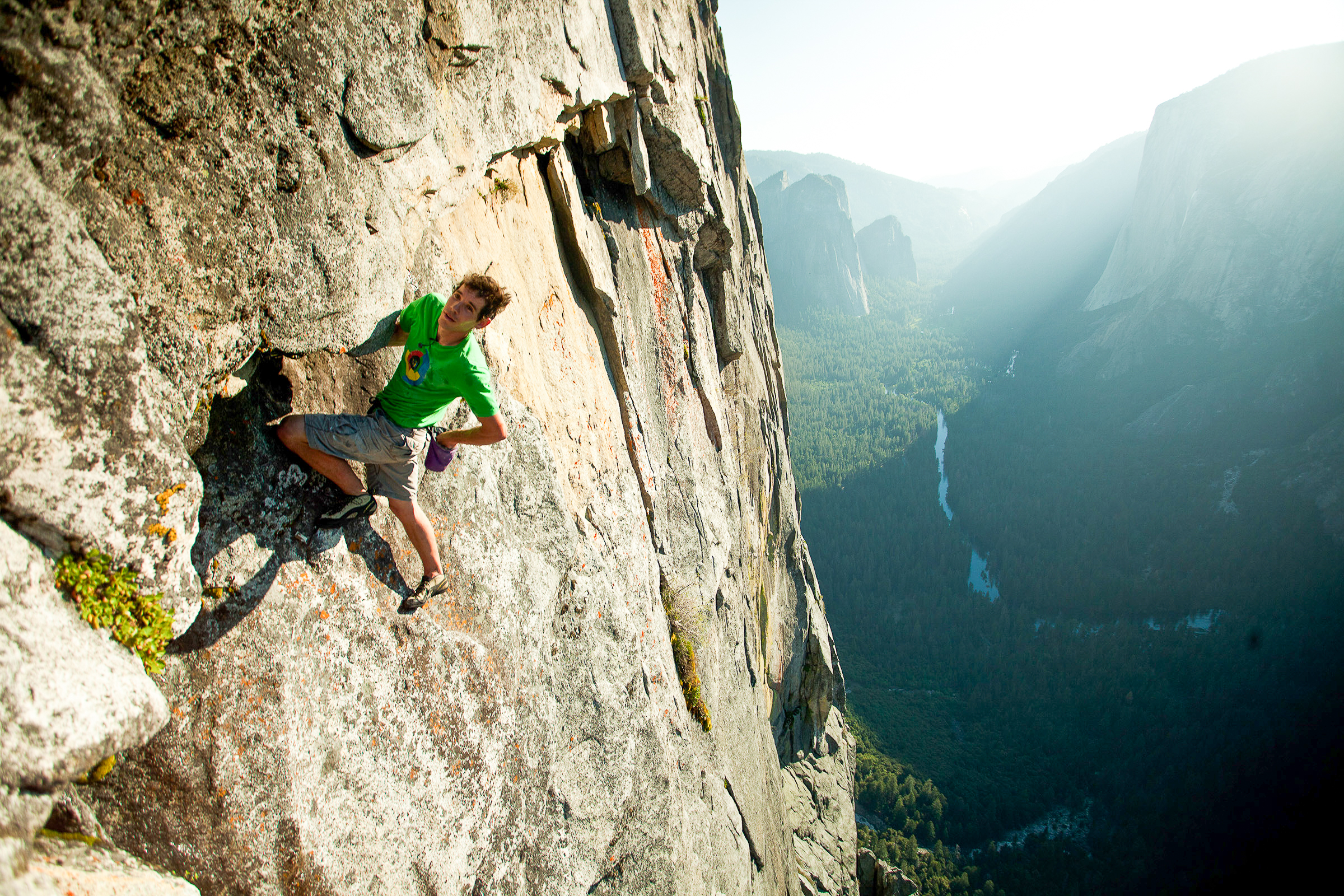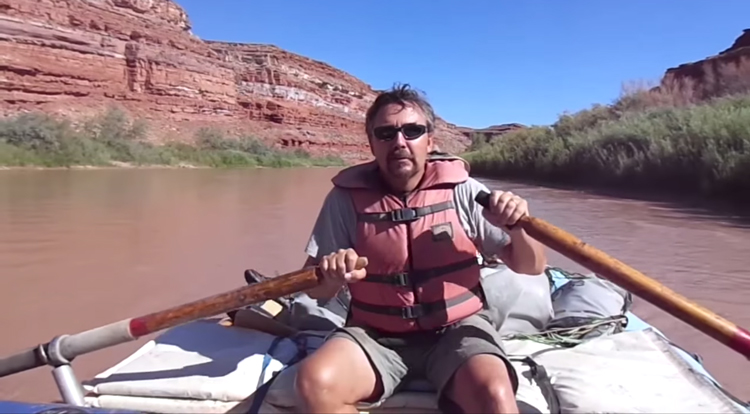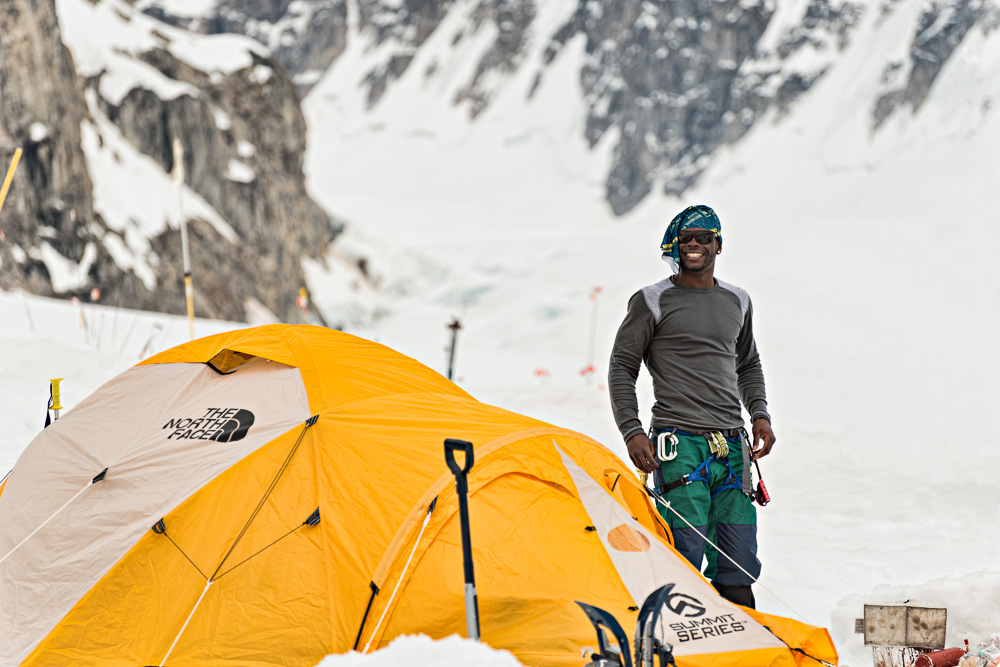JAMES MILLS AND I MET some years back when I eavesdropped on his conversation with Michael Kennedy, the then-Editor-in-Chief at Alpinist Magazine. Mills and Kennedy were discussing a team of African-American mountaineers who were training for a climb of Denali, which at 20,322 feet, is the highest peak in North America. Mills, in fact, was in the midst of drafting a piece for Alpinist about what he termed “the adventure gap.” What were the reasons, wondered Mills, for the underrepresentation of African-Americans and other people of color in the great outdoors? At this point in their conversation I found it impossible to mind my own business or hold my tongue.
I began by attacking the white monoculture that is the outdoor industry. I carefully explained to Mills, an African-American outdoor journalist, and Kennedy, a founder of outdoor magazines, how narratives and images and captions have an important steering effect on perception and participation. Outdoor journalism and marketing vehicles bereft of African-Americans, Native Americans, Hispanics and other people of color, I declaimed, my face now red, were, by omission, as guilty of prejudice as if these publications had played up false cultural stereotypes. Decelerating a bit, I described how my own youthful perusal of the Patagonia catalog had reinforced my decision to live an outdoor life. (These people look like me. If they can do it, so can I.) For good measure, I opined about social learning theory, how a monoculture is prone to sudden demise, and how the industry would find itself in a dolorous state if it persisted down its path of color-blindness.
Mills and Kennedy politely listened as I soliloquized, nodded their heads, and resumed their conversation. Obviously, I had been preaching to the choir. Later, I read Mills’ Alpinist piece and was somewhat surprised when members of the climbing community opined that race was irrelevant to the sociology of climbing. A climber was a climber, and color (or gender for that matter) shouldn’t matter.
But of course, it does.
Enlarge
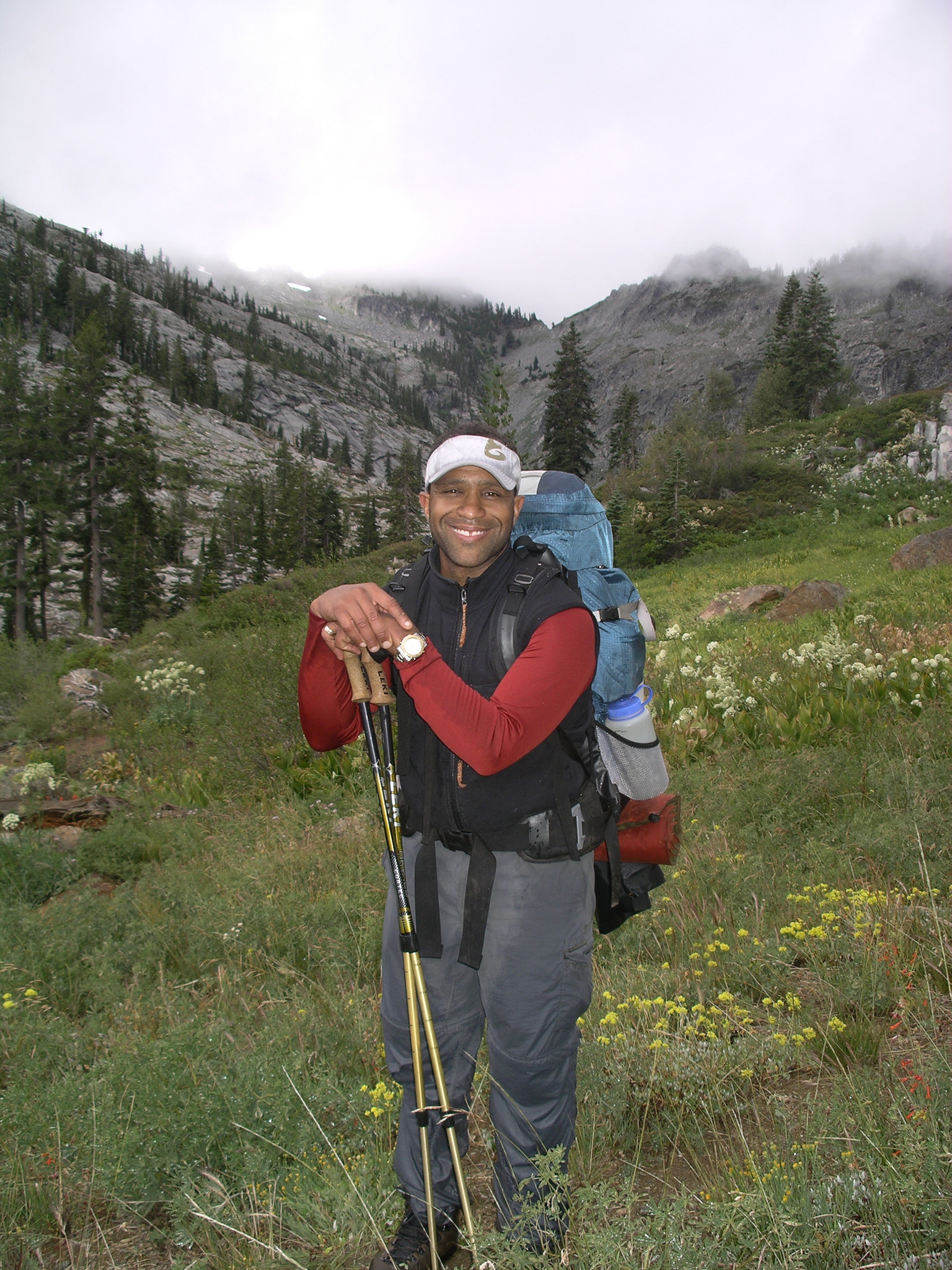
Mills Collection
Last year Mills finished writing The Adventure Gap: Changing the Face of the Outdoors (Mountaineers Books). And in one of those strange coincidences that occur when two people have the same novel notion at approximately the same time in history, the University of North Carolina Press released Carolyn Finney’s Black Faces, White Spaces: Reimagining the Relationship of African Americans to the Great Outdoors. Finney, a cultural geographer and a professor of Environmental Science, Policy and Management at the College of Natural Resources at the University of California, Berkeley — Mills’ alma mater — examines the societal underpinnings of the environmental-adventure gap through the lens of research she conducted at a South Florida environmental center, and draws many of the same conclusions as Mills.
And then Sierra Magazine asked me several months ago to write about the country’s oldest National Park Ranger, Betty Reid Soskin, now 94.
Soskin, who reports to work three times a week at Richmond, California’s Rosie the Riveter National Historical Park, closes her talks with the story of how her great-grandmother, who died at 102, her mother, who died at 101, and all were alive in the 1940s. Collectively they experienced slavery through reconstruction, Plessy v. Ferguson, the Scottsboro Boys, the Civil Rights Act and Black Lives Matter. Soskin attended Barack Obama’s 2008 inauguration with their photos in her breast pocket.
“I think if there were two things that have come with age within the last decade: I seem to have lost my rage without losing my passion,” Soskin told me. “I needed to be angry because there were lots of things to be angry about. And I don’t need that anymore. But the second thing is that I’ve learned magic in conflicting truths. Of learning to accept that we all create our own reality and that all of it is true for somebody.”

Mills, Finney and Soskin used a particular word so frequently that it became a leitmotif of sorts in explaining the adventure gap: Narrative. African-Americans and other racial minorities have been effectively excluded from this country’s environmental and adventure narratives. The upshot is that communities of color have become habituated to viewing nature or wilderness or outdoor adventure as a white person’s pursuit, and not as a natural birthright of their own, and thus stay away from the great outdoors.
As Finney writes, “the stories we tell about ourselves, others, and the places we live…provides a framework for experiencing the material world and for understanding how local stories intersect with larger social, historical, and political processes. Missing from the narrative is an African American perspective, a nonessentialized black environmental identity that is grounded in the legacy of African American experiences in the United States.”
I caught up with Mills several months ago, and we chatted about Expedition Denali, The Adventure Gap, and the power of narrative.
SP: Let’s start out by talking about your journalistic mission and the inspiration for your website, The Joy Trip Project.
James Mills: Through the course of my journalism career, one of the things that I started doing was trying to tell stories about people who engage in outdoor recreation, not exclusively for the purpose of recreation or exclusively for first ascents and highest, fastest, longest, deepest, farthest kind of accomplishments: I wanted to engage people doing things that actually had some positive social outcome. People doing things for the common good. I wasn’t terribly surprised to see that a lot of people that I’ve known in the industry for years had that as their primary ethos. So I developed a broad conversation with people in the outdoor industry about their use of recreation and adventure to help make people’s lives better. For example, one of my favorite earliest stories was a conversation with Terry Tempest Williams about her work as a naturalist poet, but also as someone who was working toward the preservation of the Utah Prairie Dog, as well helping to create the first Rwandan genocide memorial in Rwanda, Africa. I was involved early-on with Greg Mortenson’s work. That was made famous in the book Three Cups of Tea, and the work that ultimately became the Central Asia Institute. Another friend of mine was inspired by Greg’s work went on to create the first women’s cycling team in Afghanistan. I can go on and on, but I really enjoy the opportunity to tell stories about people doing incredible things in outdoor recreation.
At the same time, the adventure sports and the outdoor industries have lacked racial diversity.
Even after two decades in the business I still found myself being one of very few African-Americans in the outdoor industry. I started shifting some of my editorial priorities to look more at the roles that people of color have played, not only contemporarily, but through the history of the environmental movement as we know it today. I had the opportunity to interview Ken Burns about the National Parks documentary before it was released. Burns told me about the 400 African-American members of the 9th and 10th Cavalry Regiments, also known as the Buffalo Soldiers, who were stationed in Yosemite in 1903, and essentially became America’s first park rangers. That was a galvanizing moment for me, because even after so many years in the business and going to Yosemite dozens, if not hundreds of times, I hadn’t heard that story. If I hadn’t heard that story, that means that millions of people hadn’t heard the story, either.
Galvanizing in what way?
So it kind of got me on this jag to start talking more about people interested in environmental conservation as it pertains to increasing racial diversity — in getting people involved in both the outdoor recreation and outdoor conservation movements. So that led to a long series of magazine articles and radio stories. I just happened to be working on a piece for High Country News on diversity in the National Park system. Through the course of my conversations with different organizations, I interviewed the very first Director of Diversity and Inclusion at the National Outdoor Leadership School (NOLS). Three weeks later she called me up and said, “Hey James, what would you think if we were to put together the first team of African-Americans to try to summit Denali?” And I just said, “That sounds great. Can I come too?”
So over the next year, we put together a team of nine climbers. I was originally on the climbing team, but because of a diagnosis of osteoarthritis, I lost my spot on the team. I had to have my hips replaced and ultimately was still on the team, but as team journalist. So it was my opportunity to tell about the journey made by climbers from towns quite literally all over the country. They ranged in age from at the time 18 to 56. We ultimately put together a very dynamic team of individuals, not only good athletes with the ability to climb a mountain but who also had the ability and the wherewithal to return to their communities and tell their stories to young people. So we were in Denali National Park for three weeks. Spoiler alert, unfortunately the team didn’t summit. But everyone came back down safely after a dramatic evacuation off the top of the mountain due to an electrical storm. After they returned, they went onto college campuses and into high schools and churches and community centers, and they told their stories.
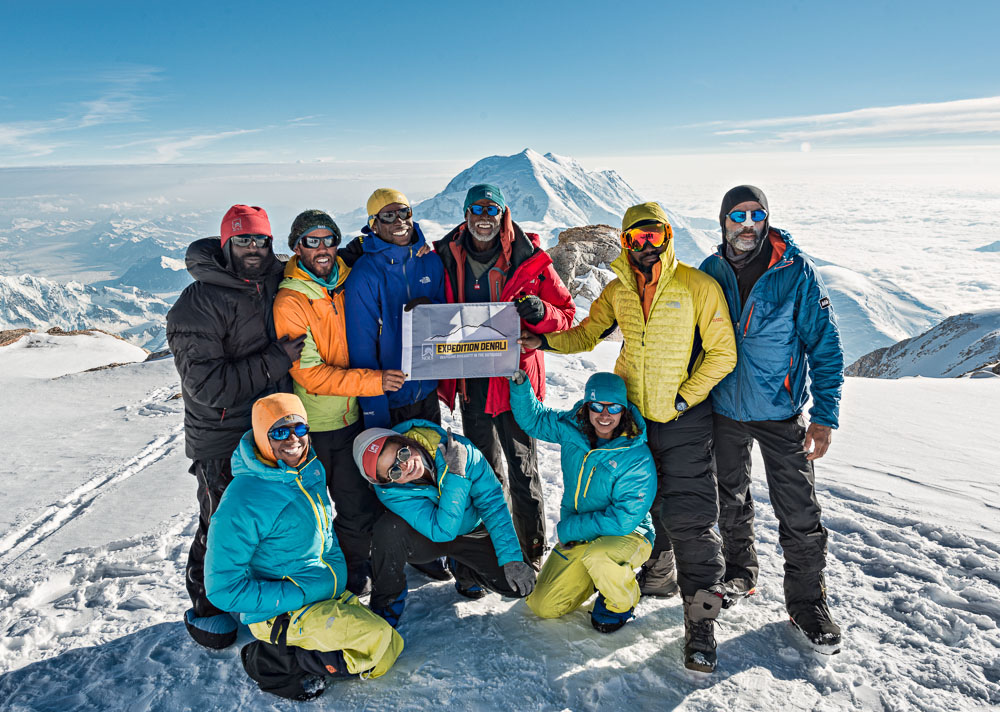
And you told theirs…
I told the collective story in my book called The Adventure Gap. We’ve also created a feature film called An American Ascent that tells the story of what has now become known as Expedition Denali. So I’ve been on kind of a national speaking tour, telling this story and also the broad story about how we need to make sure that outdoor recreation includes everybody. So that we’re not talking exclusively to a segment of the population that is exclusively or primarily one particular race or ethnicity, not one particular socio-economic status or cultural or national orientation. Outdoor recreation is for everybody.
It’s a message with important political implications, isn’t it?
As the landscape of the American population shifts to favor a non-white majority, as predicted to occur in the year 2040 – if nothing occurs to change the divide that I’ve identified as the adventure gap, there won’t be a majority constituency of American people to vote to continue to preserve wild and scenic places in this country.
What do you say to people who believe that the adventure gap will narrow organically?
The reality is that if you have a constituency of voters who have no direct relationship with the natural world, why would they ever vote, allocate federal tax dollars to support it in perpetuity to the future the way it is now? I really think that if we can increase the diversity of outdoor recreation, people who participate in adventure sports, we can ultimately protect and preserve our National Park systems, our wild and scenic places, and our natural resources for another 1,000 years. We need to act now.
You believe that increasing the visibility of outdoor recreation narratives that include people of color can be a leverage point of sorts. Talk a little bit about that.
At the core of a person’s interests or future development is the ability to see possibilities. If you’re a young person, it’s difficult to know exactly what you’re capable of doing if you don’t have affirmative role models. So if you grow up in an environment where none of your brothers, your sisters, your cousins, your aunts, uncles, grandfathers have an interest in or relationship with the outdoors and they don’t share the outdoors with you, it’s not going to be part of your ethos. Also, if you don’t see film and you don’t see images, if you don’t hear stories, if you don’t see magazine articles or newspaper stories that show people who look like you involved in the outdoors, you probably will say to yourself, “Well, no one like me has ever done such a thing, so I probably won’t either.”

Courtesy National Park Service
In The Adventure Gap you make clear that there have been role models all along. Charles Crenchaw and Sophia Danenberg, for starters.
There have indeed been a long history of people of color who have been directly involved and engaged in outdoor recreation, quite literally going back to the founding of our country through the age of exploration, through the 19th and 20th centuries.
So you’ve been traveling around the country for nearly a year promoting the book, and now the movie. What are you hearing?
It’s been incredibly positive, which is what a first-time author is always interested in hearing. But it’s also been challenging, because one of the biggest criticisms that I get is, “Is the adventure gap really a problem?” Or if it is indeed a problem, won’t it just take care of itself over time?
Will it?
I think that it’s possible. But I refuse to believe that it would just go away. I mean, why would it? Especially when we take a look at how much more urbanized we’re becoming as a culture. It’s not just a matter of whether there too few African-American or Hispanic kids are spending time in the outdoors. There are fewer people in general spending time in the outdoors. So I think that as a majority of people who don’t spend time in the outdoors grows, many will be people of color. While I’m happy to entertain the possibility that this is a problem that could very easily fix itself through the egalitarian nature of our society, we’re not taking a passive approach to addressing racial disparities that still exist across every aspect of our society. There’s the education gap. There’s the technology gap. There’s the digital divide. Why would we put effort and interest into those divides and not into the racial divide in outdoor recreation and adventure?
It seems as if there are more pressing issues, such as the way in which law enforcement officers police African-American communities.
Frankly, I think that outdoor recreation is the balm that soothes all wounds. The fact that outdoor recreation has been proven to increase health and longevity of all people who are actively engaged in it. There’s been very positive studies that indicate that the presence of trees and green space in urban areas actually have a calming effect on incidents of violent crime, that you have better community understanding and get better community organization and camaraderie around areas where you have common access to nature. So I’d like to think that if we can instill a sense of appreciation for the important of spending time outdoors, that we’ll spend more time playing and a little less time fighting with one another, and ultimately aspire to go outside of and beyond our neighborhoods so that we can actually go to our natural parks, our national monuments, wild and scenic spaces all over the country.
You’ve reported on the phenomenon of geographical “stuckness” and vicious cycles in urban environments, haven’t you?
I was tasked to do a radio story on urban gun violence in Chicago, and I interviewed a guy who was 26 years old. He’s been shot nine times on three separate occasions and has never once left the city of Chicago. Not once. Imagine a worldview fraught with that much violence based in part on the inability to escape his environment. If we had the ability to transport him someplace else, the opportunity to expand his worldview to include more dynamic, more exciting, more interesting things, I would like to think it would have a very positive outcome on the rest of his life, regardless of what it might be. In fact, there’s a program going on right now, called Rewilding. It’s the story of a young African-American man from New York City who’s being taken on his first western outdoor adventure trip. So I’m hoping that stories and narratives like this will ultimately get people to realize that there’s a world outside of the city limits, and ultimately they can escape some of the violence and maybe find some peace in the outdoors.
I recently asked Betty Reid Soskin, a 94-year-old African-American park ranger – the oldest ranger in the National Park System – about her awareness of places like Yosemite, when she was young. I’m paraphrasing, but she said, “We didn’t even think about going to Yosemite. That was a white person’s thing. It wasn’t something that we even imagined.”
African-Americans in this country, Hispanics in this country, have been fighting for infinitely more critical civil rights than access to nature. They have been fighting for the ability to live where they want to, to be able to work where they want to, to be able to marry who they want to, and also there’s financial disparities and a wide variety of other civil rights issues that had to be tackled after the Civil War, after Emancipation, through Reconstruction, through the Jim Crow era, through the Civil Rights era to today. Shelton Johnson, who is the only permanently stationed African-American park ranger in Yosemite, once told me that outdoor recreation is the last act of the civil rights movement.

Nancy DeVille
Betty figures she’s acting as a change agent simply by showing up for work each day in her National Park uniform. She sees how young girls look up to her.
Sure. When it comes to kids, especially. When they see someone who has a similar background who’s had similar struggles, who has done things that might have been impossible in their own thinking, but are indeed possible because they’re watching someone do it. They’re hearing the story. They’re being told about this great accomplishment. So that helps them, I believe, to create goals of their own, to aspire to things. Whether we’re talking about mountains or whether we’re talking about oceans. As I said in an interview recently, that’s the kind of motivation that will ultimately get us to Mars. That will allow us to think and expand our horizons far beyond where we are today. But at the end of the day, what’s most important is we take the time to realize that everybody is a hero in one capacity or another. We just have to find our role models where they have the most to contribute to our own interests in pursuing something that we might have thought was impossible.
Let’s put that within the context of adventure sports. If you’re one of the hundreds of Caucasians climbing Denali and you see a strong team of African-American climbers going for the summit, it must accomplish approximately the same thing: a virtuous cycle.
One of the most important things I want to have them think is, Wow, this is the first time I’ve ever seen a person of color in a mountaineering situation, and I wonder why I haven’t seen more. I want that person to be inclined to say, Wow, I would like to encourage more people that I encounter to do these things because there clearly aren’t enough of them. I just don’t see them relative to the number of people I see in my own hometown. At a certain point, people stop being black climbers and they just become climbers. They stop becoming black adventurers and they become adventurers, and we can revel in their accomplishments regardless of what we perceive as their cultural and social limitations.
An outdoor life is out there for anybody, then.
We must encourage people of color to not just live in the United States, but to thrive in the United States, to actually take advantage of recreation.
The right to recreate outdoors.
As a citizen in this country, it is indeed your right to recreate outdoors. If you think about it, what previous civil right can you claim more for yourself? Because as it stands right now, there are no signs that say, “Whites Only” when it comes to public lands. There are no physical limitations that prevent people of color from spending time outdoors. In many ways, it’s a personal and individual decision. A big part of what has been lacking all this time is what it is that motivates people of color to spend time outdoors. Sometimes it’s just lack of interest. Sometimes it’s lack of awareness. Sometimes it’s lack of knowledge, lack of equipment. There’s a wide variety of different individual reasons. But I honestly believe that if someone is given the inclination and the opportunity, anybody can establish a relationship with the outdoors or not. But I think that everyone should be given the opportunity to at least try. Like anything, you try it on for size. If it suits you, great. You can embrace it and enjoy a life with it. If not, you can move on to something else. But at least you had the opportunity to try at least once.
Throughout the history of this country, African-Americans have spent a lot of time outdoors against their will. Do you think that might have something to do with an aversion to recreating in wilderness?
You know, that’s a really good question and I think that that’s part of some of the issues. I’m just going to jump to the conclusion of what you’re referring to, with regard to 300 years of forced labor out of doors, followed by almost 100 years post-reconstruction of being pursued out of doors. At the risk of being, quite literally, hunted down, in some cases for sport. In some cases out of sheer racial violence and hatred. That is indeed, I think, part of the equation. But also, there’s something else that we need to keep in mind.
It didn’t end with the passage of the Civil Rights Act of 1964…
Right. There’s a phenomenon that occurred in this country right up until the early ’80s called redlining. In a redlined community a person of color could not own a home. Many of those redlined areas are in some of the prettiest, most suburban places in our county. So we had almost by national fiat a period of forced urbanization. You could have $1 million in cash, and because of some covenants in some communities, and even language included in the deeds of properties, if you were black you could not buy that home. And if that home were sold, all your neighbors could sue the previous landowner. So there has been a long history of segregation, and this is beyond slavery. This is even beyond the civil rights era. So we’re really talking about only one generation of African-Americans in this country who have had really free and unfettered access to wild and scenic spaces on a national level. So we’ve got a long way to go.

How does that play out socially? Isn’t there pressure in African-American communities to “be black?”
Yes. But if your peers recognize that this is indeed something that black people do, because they’ve seen the movies, they’ve read the books, they’ve heard the stories, it’s at that point they can say, oh, yeah, let’s get a club together. Let’s get on our bikes and let’s ride to the end of the railroad tracks. Let’s walk to the park. Let’s go fishing. Let’s cajole and guilt our parents into taking us camping. But the parents aren’t hearing this message not for the first time either, and they think, well, maybe this is the year we’ll do it. Then hopefully parents will go and they will seek out interesting books and guide services and go to retail establishments to get the equipment that they need. So narrative ultimately facilitates the experience for everybody.
So what’s happening out there?
Things are improving. They’re improving dramatically. We were here at the outdoor retailer show today, and frankly, I unconsciously count the number of people of color at this event. I’ve got to say categorically that there are more African-Americans and Hispanics this year than I have ever see, and I’ve been coming to this show for over 20 years. So that is indeed very, very, very encouraging to me.
How do you account for this increase in people of color in the outdoor industry?
I don’t think anybody can put their finger on any one reason why. Our culture is indeed changing. But the question is whether or not these new arrivals will be made to feel welcome. If we’re talking about things that are dangerous or dirty or buggy or hot or cold, or extremes in temperature or weather, or adversity, I think a lot of people – especially people of color – will avoid those things like the plague because they worked really hard to have a home, to work and sleep in a bed, and to have food on the table. Why would anybody deliberately suffer? So we need to talk about these things in ways that are relevant to their experience, so that instead of talking about roughing it, we talk about healthy living. Instead of talking about camping, we talk about glamping, where you make your outdoor experience as elegant and as comfortable as possible. You’re still in nature. You’re still outside. But you are enjoying an experience that is familiar to you in such a way that you can find yourself at home. I sincerely hope that we can make people who are new arrivals to the industry feel welcome. And that’s where we shift from diversity to inclusion, to use more inclusive language to bring more people in, to let them know that they are indeed welcome and that they’re valued.

Mills Collection
You’re speaking to the importance of overarching narratives as signifiers of the possible. What do you want journalists and storytellers to know? What faux pas are we prone to making about the African-American experience, say.
Reporters talk to me as if I’m exclusively talking about rehabilitating poor juvenile delinquents, when the reality is there are plenty of black and Hispanic kids from very affluent families who are desperately in need of the same type of guidance any inner-city kid needs to be able to have a similar experience in the outdoors. So it’s not a matter of money. As we are rebranding the outdoors, we need to brand it in ways that are interesting and relevant. Another presumption is that the best way to get kids outdoors is through trail-building or park cleanups or other activities that are, in actuality, used to rehabilitate prisoners. We should talk about these things in such a way that young people especially, are being made to feel this experience is a privilege, not a punishment.
 James Edward Mills is a 2014 Fellow of the Mountain & Wilderness Writing Program of the Banff Centre in Alberta Canada. As a freelance journalist and an independent media producer in a career that spans more than 20 years he specializes in telling stories about outdoor recreation, environmental conservation, acts of charitable giving and practices of sustainable living. Working in the outdoor industry since 1989 as a guide, outfitter, independent sales representative, writer and photographer his experience includes a broad range of expeditions that include mountaineering, rock climbing, backcountry skiing and kayaking.
James Edward Mills is a 2014 Fellow of the Mountain & Wilderness Writing Program of the Banff Centre in Alberta Canada. As a freelance journalist and an independent media producer in a career that spans more than 20 years he specializes in telling stories about outdoor recreation, environmental conservation, acts of charitable giving and practices of sustainable living. Working in the outdoor industry since 1989 as a guide, outfitter, independent sales representative, writer and photographer his experience includes a broad range of expeditions that include mountaineering, rock climbing, backcountry skiing and kayaking.
James has written for several publications that include The Wisconsin State Journal, The Capital Region Business Journal, Madison Magazine, Madison Sports Monthly and Wisconsin Trails. He currently is a contributor to several outdoor focused print and online publications that include National Geographic Adventure, Rock & Ice, Alpinist, SUP Magazine, Paddle Sports Business, Sporting Goods Business, Elevation Outdoors, Women’s Adventure, WEND Magazine, The Clymb, High Country News, Park Advocate Magazine, Land + People and Sierra Magazine.
With skills in audio storytelling James’ radio production credits include Wisconsin Public Radio, the Public Radio Exchange, American Public Media’s Marketplace, and the Public Radio International programs To The Best of Our Knowledge and The Tavis Smiley Show.
James lives in Madison, Wisconsin with his wife Shamane Mills and two lovable dogs, Reba and Bella.

